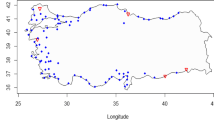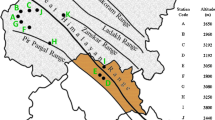Abstract
This study investigates the critical temperatures that separate rain and snow events by using hourly precipitation information, air and dew point temperatures. The study period was taken to be 1997–2016 for air temperatures and 2007–2016 for dew point temperatures. In the study, only the winter season was taken into account, as it includes both snow and rain observations. During the study period, 8 different winter periods were identified for different parts of the country. To define the temperature at the onset of each precipitation event, an interpolation was applied to hourly air temperature values. It is found that critical air temperature values range from 0.5 to 2.2 °C with an average value of 1.4 °C. In addition to critical actual temperature, critical dew point temperatures vary from − 2.1 to 1.3 °C with an average value of − 0.2 °C. As a result of this investigation, only a statistically significant relationship was found between relative humidity and critical dew point temperature. This relationship states that approximately 8–9% increase in relative humidity may cause 1 °C increase in critical dew point temperature.








Similar content being viewed by others
5. References
Auer AH (1974) The rain versus snow threshold temperatures. Weatherwise 27(2):67. https://doi.org/10.1080/00431672.1974.9931684
Collins WD, Rasch PJ, Boville BA, Hack JJ, McCaa JR, Williamson DL, Kiehl JT, Briegleb B (2004) Description of the NCAR Community Atmosphere Model (CAM 3.0). NCAR Technical Note
Dai A (2001) Global Precipitation and Thunderstorm Frequencies, Part I: Seasonal and Interannual Variations. J Climate 14:1092–1111
Dai A (2008) Temperature and Pressure Dependence of the Rain-Snow Phase Transition over Land and Ocean. Geophys Res Lett 35:L12802. https://doi.org/10.1029/2008GL033295
Ding B, Yang K, Qin J, Wang L, Chen Y, He X (2014) The dependence of precipitation types on surface elevation and meteorological conditions and its parametrization. J Hydrol 513:154–163. https://doi.org/10.1016/j.jhydrol.2014.03.038
Froidurot S, Zin I, Hingray B, Gautheron A (2014) Sensitivity of precipitation phase over the Swiss Alps to different meteorological variables. J Hydrometeorol 15(2):685–696. https://doi.org/10.1175/JHM-D-13-073.1
Harder P, Pomeroy J (2013) Estimating precipitation phase using a psychrometric energy balance method. Hydrol Process 27:1901–1914. https://doi.org/10.1002/hyp.9799
Iribarne JV, Godson WL (1981) Atmospheric Thermodynamics, 2nd edn. Springer, Netherlands
Jennings KS, Winchell TS, Livneh B, Molotch NP (2018) Spatial variation of the rain-snow temperature threshold across the Northern Hemisphere. Nat Commun 9:1148. https://doi.org/10.1038/s41467-018-03629-7
Kienzle SW (2008) A new temperature based method to separate rain and snow. Hydrol Process 22:5067–5085. https://doi.org/10.1002/hyp.7131
Matsuo T, Sasyo Y, Sato Y (1981) Relationship between types of precipitation on the ground and surface meteorological elements. Journal Meteorol Soc Jpn 59:462–476. https://doi.org/10.2151/jmsj1965.59.4_462
Motoyama H (1990) Simulation of seasonal snowcover based on air temperature and precipitation. J Appl Meteorol 29:1104–1110
Noh YJ, Liu G, Seo EK, Wang JR, Aonashi K (2006) Development of a Snowfall Retrieval Algorithm at High Microwave Frequencies. J Geophys Res 111:D22216. https://doi.org/10.1029/2005JD006826
Özgür E, Koçak K (2019) Climatology of snowfall/total precipitation days over Turkey. Theor Appl Climatol 137:2487–2495. https://doi.org/10.1007/s00704-018-02753-0
Rohrer MD (1989) Determination of the Transition Air Temperature from Snow and Rain and Intensity of Precipitation. IAHS/WMO/ETH International Workshop of Precipitation Measurement, B. Sevruk, Ed., WMO, 475–482
Ryzkov AV, Zrnic DS (1998) Discrimination Between Rain and Snow with a Polarimetric Radar. J Appl Meteorol 37:1228–1240
Slater AG, Schlosser CA, Desborough CE, Pitman AJ, Sellers AH, Robock A, Vinnikov KY, Mitchell K, Boone A, Braden H, Chen F, Cox PM, DeRosnay P, Dickinson RE, Dai YJ, Duan Q, Entin J, Etchevers P, Gedney N, Gusev YM, Habets F, Kim J, Koren V, Kowalcyzk EA, Nasonova ON, Noilhan J, Schaake S, Shmakin AB, Smirnova TG, Verseghy D, Wetzel P, Xue Y, Yang ZL, Zeng Q (2001) The Representation of Snow in Land Surface Schemes: Results from PILPS 2(d). J Hydrometeor 2(1):7–25
Stewart RE, Theriault JM, Henson W (2015) On the characteristics and processes producing winter precipitation types near 0 °C. Bull Am Meteorol Soc 96:623–639. https://doi.org/10.1175/BAMS-D-14-00032.1
Tatli H, Dalfes HN, Mentes ŞS (2004) A statistical downscaling method for monthly total precipitation over Turkey. Int J Climatol 24:161–180. https://doi.org/10.1002/joc.997
Tatli H, Menteş ŞS (2019) Detrended cross-correlation patterns between North Atlantic oscillation and precipitation. Theor Appl Climatol 138:387–397. https://doi.org/10.1007/s00704-019-02827-7
Tekin MK, Tatli H, Koç T (2021) Climate classification in Turkey: a case study evaluating Holdridge life zones. Theor Appl Climatol 144:661–674. https://doi.org/10.1007/s00704-021-03565-5
Vehviläinen B (1992) Snow cover models in operational watershed forecasting. Publications of the Water and Environment Research Institute, National Board of Waters and the Environment, Finland, Helsinki, 11: 112
WMO (2017) Manual on Codes, International Codes, Annex II to the WMO Technical Regulations, Part A-Alphanumeric Codes
Yang ZL, Dickinson RE, Robock A, Vinnikov KY (1997) Validation of the snow submodel of the Biosphere-Atmosphere Transfer Scheme with Russian snow cover and meteorological observational data. J Clim 10:353–373
Ye H, Cohen J, Rawlins M (2013) Discrimination of Solid from Liquid Precipitation over Northern Eurasia Using Surface Atmospheric Conditions. J Hydrometeorol 1345-1355. https://doi.org/10.1175/JHM-D-12-0164.1
Yuter SE, Kingsmill DE, Nance DB, Mang ML (2006) Observations of Precipitation Size and Fall Speed Characteristics Within Coexisting Rain and Wet Snow. J Appl Meteorol Clim 45:1450–1464. https://doi.org/10.1175/JAM2406.1
Zhong K, Zheng F, Xu X, Qin C (2018) Discriminating the precipitation phase based on different temperature thresholds in the Songhua River Basin, China. Atmos Res 205:48–59. https://doi.org/10.1016/j.atmosres.2018.02.002
Acknowledgements
The authors appreciate the editor and the anonymous reviewers for their time in improving the quality of the manuscript. The authors are thankful to Turkish State Meteorological Service for providing the data that made this research possible.
Author information
Authors and Affiliations
Contributions
E. Özgür performed the analysis, created the figures, and wrote the manuscript. This study was produced from a doctoral thesis and K. Koçak is the advisor of this thesis.
Corresponding author
Ethics declarations
Conflict of interest
The authors declare no competing interests.
Additional information
Responsible Editor: Zhihua Zhang.
Rights and permissions
About this article
Cite this article
Özgür, E., Koçak, K. Spatial variation of critical temperatures between snow and rain over Turkey. Arab J Geosci 14, 2726 (2021). https://doi.org/10.1007/s12517-021-08966-4
Received:
Accepted:
Published:
DOI: https://doi.org/10.1007/s12517-021-08966-4




